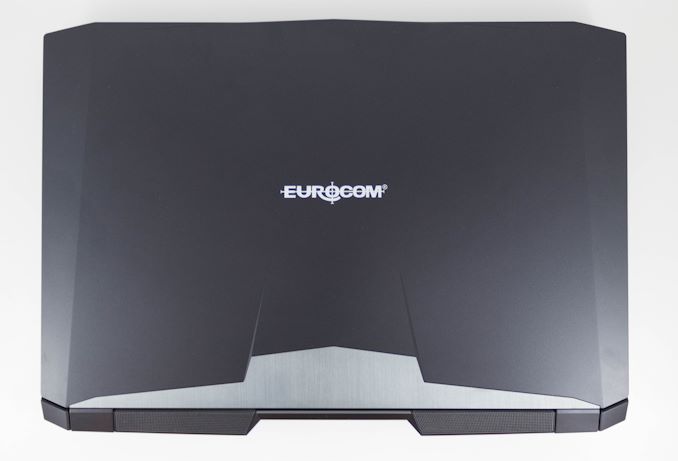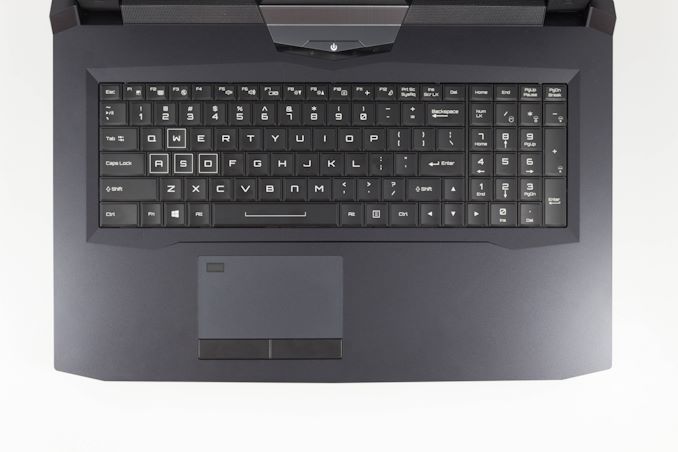The Eurocom Sky X7C (Clevo P775TM1-G) Gaming Laptop Review: True Desktop Replacement
by Brett Howse on August 5, 2019 8:00 AM ESTDesign
Eurocom is leveraging the Clevo P775TM1-G laptop as their base chassis for the Sky X7C, and if you’ve ever had a chance to use a Clevo laptop before, it is certainly function over form in every respect. There’s no fancy aluminum CNC chassis, but instead a big, bold, black plastic exterior, with no fancy graphics or lighting. Every dollar you pay goes into what is inside, rather than outside.
The Eurocom Sky X7C is a big laptop. It measures 40 mm / 1.6-inches thick and weighs in at a hefty 3.9 kg / 8.58 lbs. This is true desktop replacement territory, offering the size and weight to be able to handle the extra cooling that the desktop class components will require. As a DTR notebook, it’s meant to be moved from desk to desk, rather than used on the go.
The no-nonsense black plastic continues when you lift the display open. This notebook doesn’t offer the ultra-thin bezels you may expect on a smaller, lighter laptop, and the imposing size doesn’t offer the modern look from some of the more expensive competition.
If you are familiar with Clevo keyboards, this is as standard as they come. Clevo offers a full keyboard plus number pad, and it offers reasonable key feel and throw. There’s only three zones of RGB backlighting, rather than per-key like some of the competition, which limits the usefulness of the backlighting for anything other than being able to see in the dark. Per-key does offer some benefits to quickly find certain keys, or change the mapping based on application, whereas three zones, to me, looks a bit silly if all of the zones are not set to the same color.
The trackpad offers the same no-nonsense approach, with a pretty average trackpad. There’s no glass top for smoothness, but it is responsive enough and works well with multi-touch. There’s also actual buttons located below the trackpad, which is beneficial for gaming if you don’t have access to a mouse. Clevo also includes a fingerprint reader in the trackpad as an added convenience.
The sides of the laptop offer plenty of expansion ports, with four USB Type-A ports split across the right and left, and two USB Type-C ports on the left side. There’s also a SD card reader and Ethernet on the left, and four 3.5 mm jacks for the audio on the right. If there’s a small quibble here, it would be that the Ethernet cable should be located on the rear to make the cabling a bit cleaner if you do want to use wired Ethernet, where it would join the two DisplayPort outputs, the HDMI 2.0 port, and the massive 4-pin power connector.
Clevo laptops are function over form, which is really their charm, and allows them to offer more performance for less cost than most, if not all, of the competition. The design of the Eurocom Sky X7C is typical Clevo, but it still offers a reasonable keyboard and trackpad even if the overall fit, finish, and feel don’t quite stack up with the sleek aluminum you’d normally see on a gaming laptop in this price range. There’s plenty of expansion, and you could easily run this as a true desktop with a display, keyboard, and mouse connected with no fuss.
















46 Comments
View All Comments
p1esk - Monday, August 5, 2019 - link
I love the option of 1440p at 120Hz! Hope to see it in normal laptops (perhaps new MBPs can lead the way to improved refresh rates?)HollyDOL - Monday, August 5, 2019 - link
Since the article title talks about 'true desktop replacement', could we get price and performance comparison to desktop with "same" parts? ie. DDR4-3000 + 9900K + RTX 2080...Brett Howse - Monday, August 5, 2019 - link
Our GPU bench is currently an i9-9900K as well. As a comparison I got 116 FPS on Shadow of the Tomb Raider, and Ryan got 114.6 with the desktop version, so the performance seems similar. Unfortunately we don't have a lot of overlap on our tests though because Ryan is able to keep GPUs and benchmark them on new suites whereas laptops have to go back to the manufacturers so I don't rotate the tests as heavily since every time I add a new test it starts out with zero results to compare against.Is there a particular title you'd like to see compared against other than Shadow of the Tomb Raider?
HollyDOL - Tuesday, August 6, 2019 - link
nice, thanks...Compile Chromium (time) test would be nice...
or in general anything that puts the machine under high sustained stress for longer period (45mins+)...
craz8 - Monday, August 5, 2019 - link
I have one of these laptops - a Sager branded one.It really is quite heavy, and the 330W power brick is equally beefy - I selected the RTX 2070 to avoid needing double power bricks. I do use this on my lap, but the power plug at the back falls out a lot in this configuration. It's not a very secure connection. Since it's at the back, the only way to notice is that suddenly the CPU is running at 1.3Ghz instead of 4+
I almost always run this in Quiet mode, as the fans are almost silent in this mode. When I'm stressing the machine, the CPU clocks down to about 3.4-3.6 Ghz, which is still good enough for the work I do on it. If I run in performance mode, the things I run go a little faster, but the fan noise is not worth the extra speed.
There really isn't enough cooling for Nvme drives. Even small amounts of writing to them immediately pushes the temps to 90+, and there's no room for extra heatsinks to help with this.
I have the 4K screen, which seems pretty good, but if you dual boot into a Linux OS, the bootloader screen is hilariously small, and some versions of Linux have poor scaling options
I mostly use this on my desk, and it (or Windows 10) really doesn't like my CalDigital TB3 dock. Luckily, everything plugs into the chassis (unlike recent Apple hardware)
I don't play games on this, so barely use the GPU (RTX 2070). I'd love to have options to push more power and cooling to the CPU whilst scaling them back to the GPU without having to poke at the values manually.
Overall, I like mine, but it does have quirks.
Alistair - Monday, August 5, 2019 - link
I think you'd be much better off with a (I hate to say it) nVidia creator laptop, or a 9880H/9980HK laptop with a 120/144hz Gsync IPS screen. We need a comparison with Clevo of the MSI Stealth and Raider and Titan.https://www.newegg.com/matte-black-with-gold-diamo...
Brahman05 - Monday, August 5, 2019 - link
I have sager's version of the x9e2 with a 7700k and 1080sli and the same 1440p panel, and the panel is both one of the best and worst parts in the thing. One thing not mentioned in this article is the gtg does not really support the refresh rate, but by reporting a 120hz refresh it at least still cuts down on input lag. I really have no complaints though. When I got it I had a mobile lifestyle and had the money for it, my only two real gripes are ZEN and RTx. Not 3 months after I got the thing AMD goes and makes 8c16t a thing and even if the architecture is pretry much the same from the 6700k to the 9900k the productivity of the same class chip is now double. And with RTX going to NVLink for an sli bridge Nvidia has axed mobile sli due to the complexity involved in producing that type of connector. So this X7c is really the way to go anymore. Damn you progress!LsRamAir - Monday, August 5, 2019 - link
No Overclocking detail... bahhhh! Pushing these DTRs to the max that their cooling allows for is what at least half of their buyers do... Next time, yes please! (Especially in the wake of similarly spec'd DTR machines burning out under mild OC's, which SHOULD NOT HAPPEN, it would be nice to know if this SKY is also part of the bad choices group.)peteraustin - Tuesday, August 6, 2019 - link
Amazing article https://www.anandtech.com/ you should definitely read it in your spare timehennes - Tuesday, August 6, 2019 - link
I recently got this laptop as a replacement for a 10 1/2-year-old laptop. I wanted a full-sized keyboard, which means 17” or larger. Potable means 17” really it the limit. And 17” is perfect for 2k screens.The Sky X7 was one of the few which offered that and it had all my desired other connectivity (multiple NVME, multiple DP out, a few fast USB ports, thunderbolt, …
What really was surprising is how few other there are. Many with low res displays (1920x1080) which makes sense for gaming. Some with 4K displays future proof but quite small on a 17” display.
That made the X7C almost the only sensible choice.
And from an engineering view the thicker than average body was also very attractive. As were the looks. Form over function simply looks good, while designed stuff tend to look odd and twisted to me.
The only thing it lacks for me is more battery capacity. Lugging the large charger around is not fun and two battery slots (or 2x 80) for airplane use would have been my choice if it was offered.